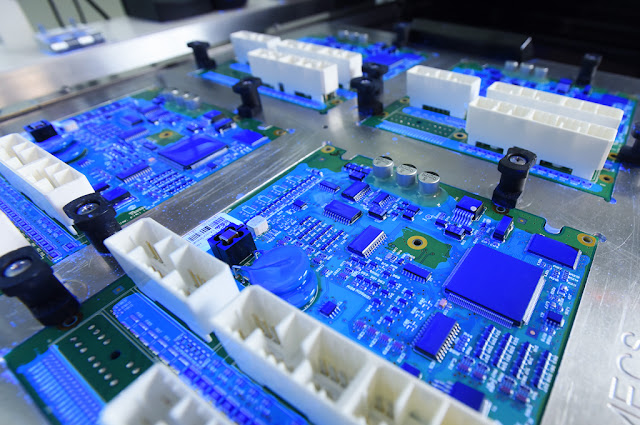 |
| Conformal Coatings |
Conformal coatings are thin protective coatings that are applied to
printed circuit boards and other electronic components to help protect them
from various environmental factors. As electronics become more miniaturized and
compact, conformal coatings play an increasingly important role in protecting
delicate components and preventing failures.
Types of Conformal Coatings
There are several different types of conformal coating materials that are
commonly used, with each having their own advantages and applications.
Acrylic Coatings
Acrylic conformal coatings are some of the most widely used coating materials.
They offer good moisture and chemical resistance along with abrasion
resistance. Acrylic coatings cured at room temperature are fast drying but
offer less protection than thermally cured varieties. Fully cured acrylic
coatings can withstand temperatures up to 150°C.
Silicone Coatings
Silicone conformal coatings are more expensive than acrylic but offer excellent
flexibility and thermal shock resistance. They can withstand continuous
operating temperatures as high as 200°C. This makes them well suited for
applications in harsh environments or with frequent temperature fluctuations.
Different types of silicone coatings such as moisture cure and UV cure are
available.
Urethane Coatings
Urethane Conformal
Coatings fill the gap between acrylics and silicones by offering
performance in between the two. They are flexible like silicones but less
expensive. Urethane coatings can withstand temperatures from -50°C to 150°C and
are water resistant as well. Two part urethane coatings provide excellent
adhesion and protection.
Other Types
Other specialty conformal coating materials include epoxies, polyurethanes, and
parylene. Epoxies provide the highest level of protection against moisture and
chemicals but require high temperature curing. Polyurethanes are flexible like
silicones but can withstand up to 200°C. Parylene coatings are vapor deposited
under vacuum for a uniform pinhole-free coating, but the equipment costs are
high.
Conformal Coating Properties and Applications
The ideal conformal coating material will possess certain key properties to
protect electronic components in different environments and applications.
Protection from moisture and chemicals is critical for coatings used in harsh
and wet conditions. Resisting corrosion is important when components will be
exposed to saltwater, chemicals or humidity. Conformal coatings must exhibit
good barrier properties.
Flexibility is necessary if the coated board will experience thermal or
mechanical stresses. Rigid coatings could crack or peel. Materials like
silicone and urethane remain flexible over a wide temperature range.
Adhesion to the substrate is important to prevent the coating from flaking or
peeling off over time. Proper surface preparation and coating selection ensures
a strong bond between coating and PCB.
Dielectric strength provides insulation to prevent arcing between conductors.
High voltage electronics require a conformal coating that won't break down at
higher voltages.
Some other key properties include curing temperature which affects throughput,
voltage standing capacity, and coating thickness requirements unique to each
application.
Common applications that benefit from conformal coatings include motors and
generators, industrial equipment, avionics, automotive circuits, and consumer
appliances that experience moisture, chemicals, vibration or thermal stresses.
Military, aerospace and medical devices also rely on coated boards for enhanced
reliability.
Conformal Coating Process
The conformal coating process typically consists of the following basic steps:
1. PCB Preparation - Boards are cleansed to remove oils, fluxes and
contaminants using solvent washing or plasma etching. This promotes coating
adhesion.
2. Coating Application - Common methods include dip coating, spray coating and
selective coating using automated equipment. Automatic applicators ensure
uniform coverage.
3. Curing - Most coatings require a curing stage utilizing heat, UV light or
air drying to fully crosslink the coating material. Curing hardens and sets the
protective properties.
4. Inspection - Coated boards are visually and manually inspected to check for
defects, pinholes or thin spots before electrical testing. Automated optical
inspection may also be used.
5. Testing - Simple electrical functional checks and isolation resistance tests
are usually run initially to certify the coating process. Additional testing
like thermal shock may be required.
6. Repair - Any boards failing inspection can be reworked by selectively
removing the failed coating and reapplying in problem areas.
Proper selection of coating type along with a well-controlled and reproducible
process ensures maximum protection for electronics. Conformal coatings play a
key role in reliability and product lifetime.
Conformal coatings have become increasingly important for protecting
electronics from harsh and changing environmental conditions. The types of
coating materials, their properties and applications were discussed along with
the basic conformal coating process flow. As electronic products move to new
form factors and applications in industries like automotive, aerospace and
medtech, conformal coatings will continue evolving to meet protection needs and
improve long term reliability.
Get More Insights On This Topic: Conformal
Coatings
Explore More Related Topic: Liquid
Chromatography Mass Spectrometry (LCMS)
